Music is the universal language
“Glory to God in the highest heaven, and on earth peace to those on whom his favor rests.” - Luke 2:14
Premier Guitar
PRS Guitars Releases 40th Anniversary Custom 24 Satin Limited Edition
PRS Guitars today announced the launch of the 40th Anniversary Custom 24 Satin Limited Edition. This release celebrates four decades of PRS Guitars by bringing some new and noteworthy features to the model that started it all. Limited to 500 pieces worldwide, this special edition uniquely features a mango top, ebony fretboard, satin nitro finish, and smoked black hardware for a new twist on a classic. Each guitar includes a 40th-anniversary certificate hand-signed by Paul Reed Smith.
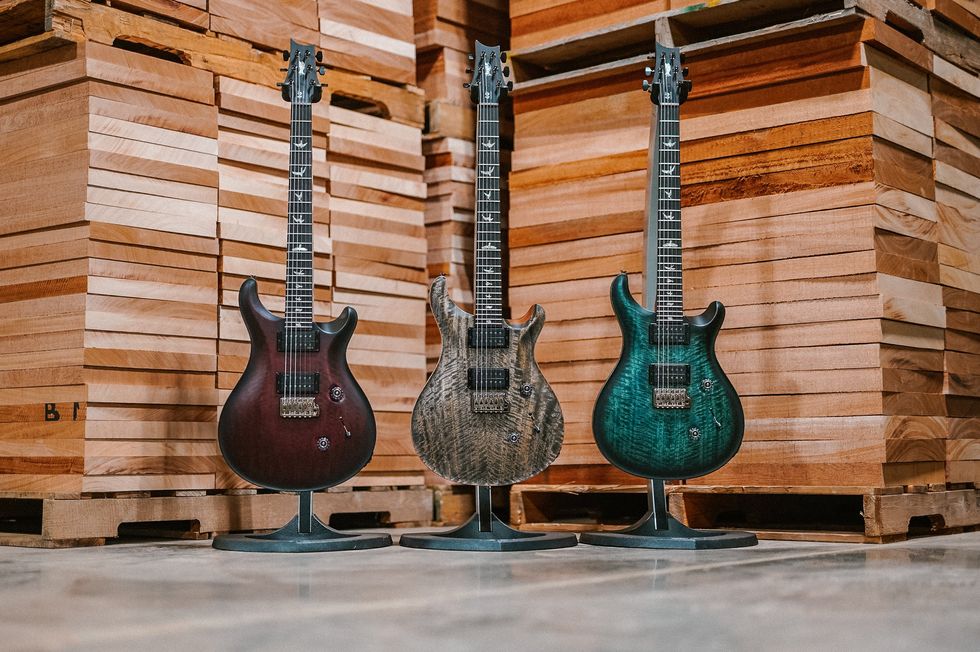
“Our wood buyers search the world over for the most extraordinary tonewoods available. These mango tops (also on the new Mark Holcomb signature model) that they acquired are visually stunning. They also have this ringing resonance to them. Featuring the new wood along with the other unique appointments give this edition of our flagship Custom 24 its own unique character, worthy of a limited, anniversary model,” said Paul Reed Smith.
While the guitar may look different, it boasts many of the Custom 24’s beloved features, including a mahogany back and neck, 25” scale length, 24 frets, 10” fretboard radius, and Pattern Thin shape. Other classic Custom 24 appointments include the PRS Gen III patented tremolo, PRS Phase III locking tuners with wing buttons.
Most notably, this limited edition exchanges the Custom 24’s classic maple top for striking figured mango. Mango wood retains much of the sound characteristics as maple while bringing an almost “quilted” look to these guitars. The satin nitro finish adds to the guitar’s unique aesthetic appeal by bringing a more natural vibe to the instrument. The ebony fretboard and headstock veneer feature PRS “Old School” birds with outlines and a PRS “Pre-Factory” eagle on the headstock, which both pay homage to early PRS guitars.
The 40th Anniversary Custom 24 Satin Limited Edition is equipped with PRS’s DMO Treble and Bass pickups. DMO pickups (DMO standing for Dynamic, Musical, Open) were spec’d by Paul Reed Smith and the PRS New Products Engineering team to have a wide-open sound with vocal character. Paired with a 5-way blade switch, these pickups give players plenty of tonal range in their dual octave package.
PRS Guitars continues its schedule of launching new products each month in 2025. Stay tuned to see new gear and 40th Anniversary limited-edition guitars throughout the year. For all of the latest news, click www.prsguitars.com/40 and follow @prsguitars on Instagram, Tik Tok, Facebook, X, and YouTube.
Last Dance with Dorian

Theory: Intermediate
Lesson Overview:
• Learn how to construct Dorian scales.
• Understand the minor-key harmony of “Last Dance with Mary Jane.”
• Develop an ability to hear the raised 6 in a minor scale. Click here to download a printable PDF of this lesson's notation.
I love modes. I love playing them. I love teaching them. But they are tricky to teach because it’s difficult to wrap your head around them without having to dive deep into theory, which isn’t an easy step for some players. As a teacher, I look for ways to make modes fun and relatable, and this always lives and dies by the quality of your examples and source materials. Over this past holiday break, I started researching the mighty 5-watt Fender Champ tube amp. What does this have to do with modes? Read on.
Tom Petty’s guitarist Mike Campbell is a well-known fan of low-wattage Fender amps. I was watching a segment on the history of the Champ and when the main riff to “Last Dance with Mary Jane” came up, it piqued my interest. It was a song I knew well, hadn’t really heard in a long time, and never had a reason to study—until now.
There was something about the song that was unique and I wanted to dig into. And because I needed inspiration for a new lesson, the timing was perfect. The first thing I like to do when figuring out how a tune works is to lay out the main chords as an inventory. For this tune, the chords are pretty simple:
Am–G–D–Am
Yet again, Tom Petty takes a simple harmony and crafts an enduring rock anthem around it. We all joke about three-chord rock, but this is not only three-chord rock, it’s modal as well. So, why is this a Dorian chord progression? Just looking at the chords might be enough if you’d studied harmony a ton, but if you haven’t, the next step we should take is to spell out the chords into their individual notes:
Am = A C E
G = G B D
D = D F# A
Now that we’ve deconstructed the chords, the next task is to decide which note you think is home, or in theory-speak, the I. In this case, it’s pretty clear that A is home. We keep coming back to it, and it really does feel and sound right. With that done, we can take the chord tones and alphabetize them, starting with A. This yields a string of seven notes: A–B–C–D–E–F#–G.
Okay, we’ve taken inventory of all the notes contained in those three chords, starting from our root (A). The next step is to ponder the harmonic consequences of this discovery. What makes this a Dorian progression is the D major chord with an Am tonic. This D triad brings us an F#, which is not the normal F you’d see in an A Aeolian, aka A natural minor, scale (A–B–C–D–E–F–G). With Dorian, you end up with a scale that sounds minor, but with a raised 6, compared to natural minor. This yields an intriguing sound that’s not quite as dark as the minor scale you’re accustomed to. Many people describe and teach Dorian as a minor scale with a raised 6, and that’s exactly what we have here.
To get familiar with this sound, grab “Last Dance with Mary Jane” on your favorite music service and play along in A Dorian. Ex. 1 shows a handy scale diagram based on the 5th fret root of A on the 6th and 1st strings.

Now that we’ve connected the chords to the Dorian mode and we have a scale fingering, let’s hear some riffs in context.
For Ex. 2, I’m keying off the fact that this Dorian scale position is in the same spot as the familiar minor pentatonic scale, so we’re getting to use both the mode and the pentatonic in the same phrase. I’m featuring the F# (or the 6) as the signature note that makes Dorian unique, and also because it’s the 3 of the D major chord. You can play that F# whenever you want in this progression, but it’s extra awesome over the D chord.
Click here for Ex. 2
With its bluesy beginning, Ex. 3 is another line that relies on the pentatonic scale lurking inside of the Dorian scale. Again, when the D major chord occurs in the second measure, I’m calling attention to it with the F#. It’s a simple way to connect with the Dorian scale and still keep that rock/blues feel we all love.
Click here for Ex. 3
For our final example (Ex. 4), I stayed away from the pentatonic sound and tried to create a simpler melody with just the Dorian scale. It starts in the middle of the guitar’s range and follows a see-saw pattern of “go up a few, go down a few.” At the start of each chord change—every two beats—I align to the chord in the progression: A for the Am chord, G for the G chord, and F# for the D chord. This is a little bit of voice-leading that reminds me of “While My Guitar Gently Weeps.” It not only helps you anchor the chord progression, but it connects with the mode at the same time. We’re only using a portion of Ex. 1’s two-octave scale pattern—sometimes simple is best.
Click here for Ex. 4
But wait there’s more! While the opening chords clearly spell out an A Dorian progression, the chorus shifts to yet another modal key. This song keeps on giving us things to learn and practice—how cool. When the chorus starts, we hear the following chords:
Em–A–Em–A–G
As before, let’s pull the chords apart to see what’s inside:
Em = E G B
A = A C# E
G = G B D
And just like last time, we need to determine the root. In this case, it’s clearly E minor, so we’ll call this an E something mode. Starting with E, let’s ascend through the pitches to see what we get:
E–G–A–B–C#–D
This gives us six notes. While we’re missing the second note after E (which, in a seven-note scale, would be some type of F), we can still conclude it’s another Dorian scale, this time in the key of E. Relative to E, C# is a raised 6 and this matches our general idea of Dorian construction: minor scales with a raised 6. It’s really cool that this song allows you to practice in two keys, A Dorian for the verse and E Dorian (E–F#–G–A–B–C#–D) for the chorus.
Ex. 5 is a scale diagram for E Dorian. Note that it’s the same pattern as our previous A Dorian scale, just shifted up to the 12 fret to place the E root on the 6th and 1st strings.

The chorus is my favorite part of the song because it’s a moment where everything comes together—the chords and Petty’s vocal melody combine for a beautifully haunting Dorian sound. Pay attention to the “ry” in the melody of “Mary” to hear that C# over an Em chord—that’s the distinctive Dorian color at work. It’s one of the reasons I’ll keep this song in my arsenal of material for teaching Dorian to students, along with Pink Floyd’s epic “Breathe” from Dark Side of the Moon. (Go work out the Dorian key for that one.) For now, use the above examples for inspiration and find your own riffs and ideas for “Mary Jane.” Let your creativity and ears be your guide.
I hope you enjoyed exploring how to reverse-engineer a simple song. Over time, this process will become faster and you’ll be able to hear the modes more easily. The next time a tune really tickles your ear, take it apart as we’ve done here. Who knows? It may spawn a soloing concept or a song idea you wouldn’t have otherwise considered.
Mastodon Founding Guitarist Brent Hinds Dies at 51

Brent Hinds, the cofounding guitarist of veteran Atlanta metal band Mastodon, died last night, August 20, after a motorcycle crash. According to Atlanta News First, Hinds was riding a Harley-Davidson and collided with an SUV, which failed to yield while turning through an intersection. His death was confirmed by the Fulton County medical examiner’s office.
Formed in 2000, Mastodon’s original lineup of Hinds, bassist/vocalist Troy Sanders, guitarist Bill Kelliher, and drummer/vocalist Brann Dailor remained unchanged until this year. Hinds’ playing, often powered by Gibson guitars and Orange amplifiers, earned him recognition as one of the most potent, powerful guitarists in modern metal. Hinds also played with the bands Fiend Without a Face, Giraffe Tongue Orchestra, Legend of the Seagullmen, and West End Motel.
Hinds left Mastodon in March this year on what appeared to be amicable terms, but his exit seems to have been more acrimonious than initially reported. In the past few weeks, a series of social media posts from the guitarist criticized his former bandmates and suggested that he was kicked out of the band.This morning, fans and peers began leaving messages of love and remembrance on Hinds’ latest Instagram post, uploaded yesterday.
Earlier today, August 21, Mastodon shared a tribute to Hinds on their official social media:
We are in a state of unfathomable sadness and grief… last night Brent Hinds passed away as a result of a tragic accident. We are heartbroken, shocked, and still trying to process the loss of this creative force with whom we’ve shared so many triumphs, milestones, and the creation of music that has touched the hearts of so many. Our hearts are with Brent’s family, friends, and fans. At this time, we please ask that you respect everyone’s privacy during this difficult time.
The Best of All Eras: The One-of-a-Kind Partscaster Jazzmaster
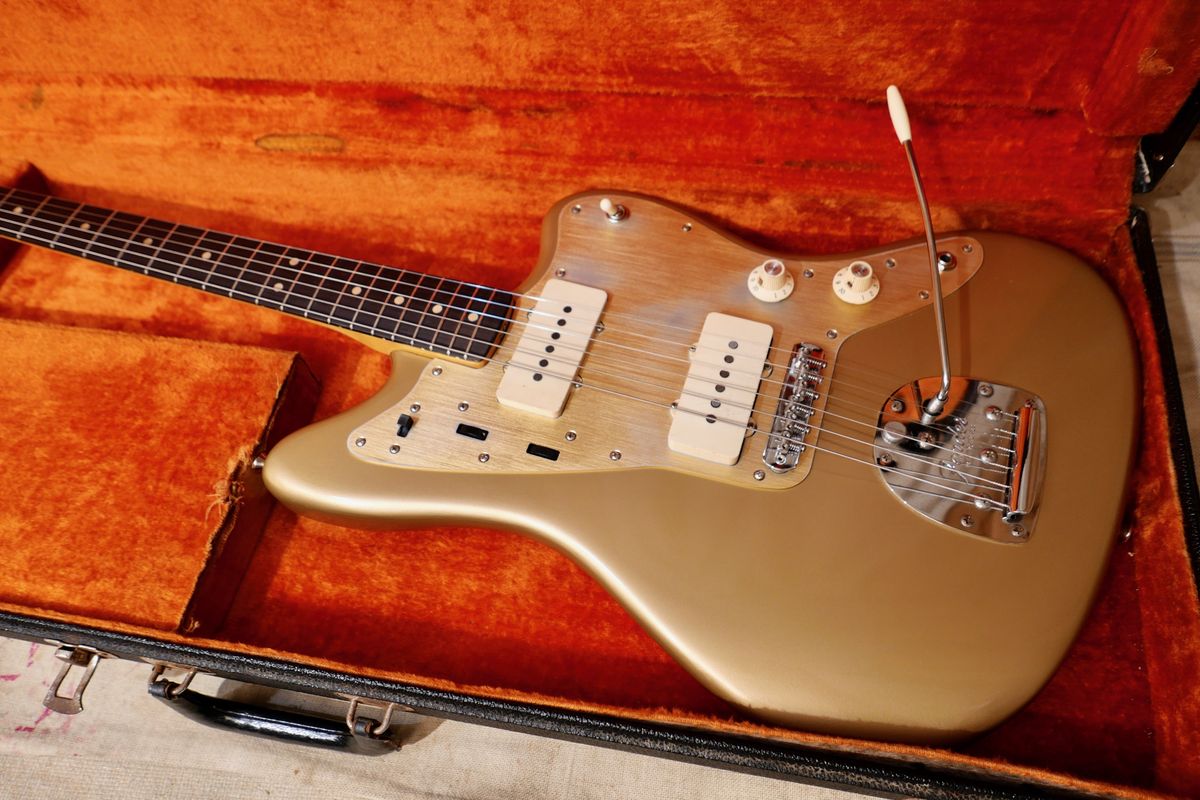
Vintage Fender cool at an even cooler price.
Back when Leo Fender was first designing his namesake instruments, he made a key decision that few of his contemporaries considered: bolt-on necks.
Gibson, Epiphone, Gretsch, and other companies of the era were often dedicated to the traditional construction method of set necks, where a joint is crafted at the butt end of the neck from the very same piece of wood, fitted into the body, and glued in place. Leo took what he saw as a more eminently practical approach: Just screw the thing on.
In an interview with guitar writer and historian Tom Wheeler many years later, he explained his decision: “I did it because when you build a guitar and neck that are joined in one piece or bonded, then, when you have a flaw in the neck, you have to decide between putting up with it or junking the whole damn thing—body, neck, and all. So I decided that it’d be best for the customer if I built the body and neck separate. It’s functional. That’s why we did it.”
To anyone that has read about Leo’s design ethos before, you’ll recognize that this idea of practicality was central to nearly everything he did. He wanted Fender instruments to be made, first and foremost, for working musicians, like the gigging country and western pickers he catered to in 1950s Southern California (and who he often used as beta testers throughout his guitars’ development).
Did your neck take a beating at some rowdy honky-tonk? Bolt on another. Did a pickup crap out? Pop off the pickguard and swap in a replacement. Oh, the Telecaster’s body is digging into your ribs? Let’s rout some contours into these new models so it feels more comfortable. Or so the thinking went.
Compared to the delicately featured archtops coming out of other shops in the mid-20th century, Fenders were built to perform. One great consequence of this decision is that it spurred the creation of “partscasters.”
This compound word can be defined as the amalgamation of various parts (parts-) in an otherwise Fender or Fender-style guitar (-caster). And it’s certainly not always the case that parts are swapped only when issues arise, but also when an owner makes the intentional decision to try a new body, neck, or electronics to go after a particular feel or sound.
“This guitar is a marriage of pre-CBS feel, CBS-era savings, and mostly modern electronics and hardware that are sure to last.”
The benefits of this approach are many, especially if you’re buying a partscaster someone else has already built. By and large, on the used or vintage market, a partscaster will almost always be less expensive than a factory-original model of the same era—they are often even less expensive than if you bought each part individually—and it could very well be a better playing guitar, to boot.
Case in point: The vintage partscaster Jazzmaster featured in this edition of Vintage Vault. For sale by the fantastic Reverb seller Southside Guitars, this partscaster Jazzmaster is a true player’s instrument. It has a 1964 neck—the last year in which the coveted Brazilian rosewood fingerboard was used on production models—attached to a 1972 Jazzmaster body, which can be a tad heavier than ’60s models but is the same shape and dimensions.
Overall, this guitar is a marriage of pre-CBS feel, CBS-era savings, and mostly modern electronics and hardware that are sure to last. While the tremolo and neck plate are original, nearly everything else has been replaced, with Seymour Duncan pickups taking the spot of the ’70s Fenders and both the body and the pickguard getting refinished in gold sometime in the past.
The best part of all these changes? The asking price of $4,980. While still a good chunk of change, that is significantly less expensive than any all-original ’64 Jazzmaster you could find, which, these days, can easily approach or pass the $10,000 mark. (Back when they were released, a ’64 Jazzmaster would have retailed for $349–$429, and ’72s would have been $419–$439. Adjusted for inflation, either model would cost at least $3,500 in today’s dollars.)
Vintage guitar prices, on the whole, have hit some of their highest peaks in recent years. At Reverb, from 2015 to 2023, we saw increasing prices not just for the fashionable pre-CBS Strats and Teles and equivalent pre-Norlin Gibson Les Pauls, but basically anything under the vintage umbrella. Some collectors will pay hundreds of dollars for original screws if that’s what they need to complete an otherwise all-original specimen. If parted out (again) from this Vintage Vault Jazzmaster, the original neckplate alone could go for a few hundred dollars, while the ’64 neck and ’72 body could fetch many thousands of dollars apiece.
So, if you’re a buyer who is interested in owning and playing a vintage guitar, you’d do well to remember the working-musician ethos with which Leo started the brand and consider a vintage partscaster. A different neck or different pickups is not the mark of a lesser instrument, but the mark of a well-played gem.
Sources: American Guitars: An Illustrated History by Tom Wheeler; Gruhn’s Guide to Vintage Guitars by George Gruhn and Walter Carter, Reverb Price Guide sales data
Nashville’s Modern Honky-Tonk (Guitar) Hero
John Bohlinger spends some quality time with the Telecaster powerhouse keeping Don Kelley’s legacy burning bright at Robert’s Western World. McQueary shares some subtle tone tips, recounts memories of performing alongside his heroes (and Kelley alumni), explains his constant pursuit of nuance in tone—often finding more magic in playing softly than turning up, and details the journey that took him from bystander to Nashville Broadway showman.
Digitech HammerOn Review
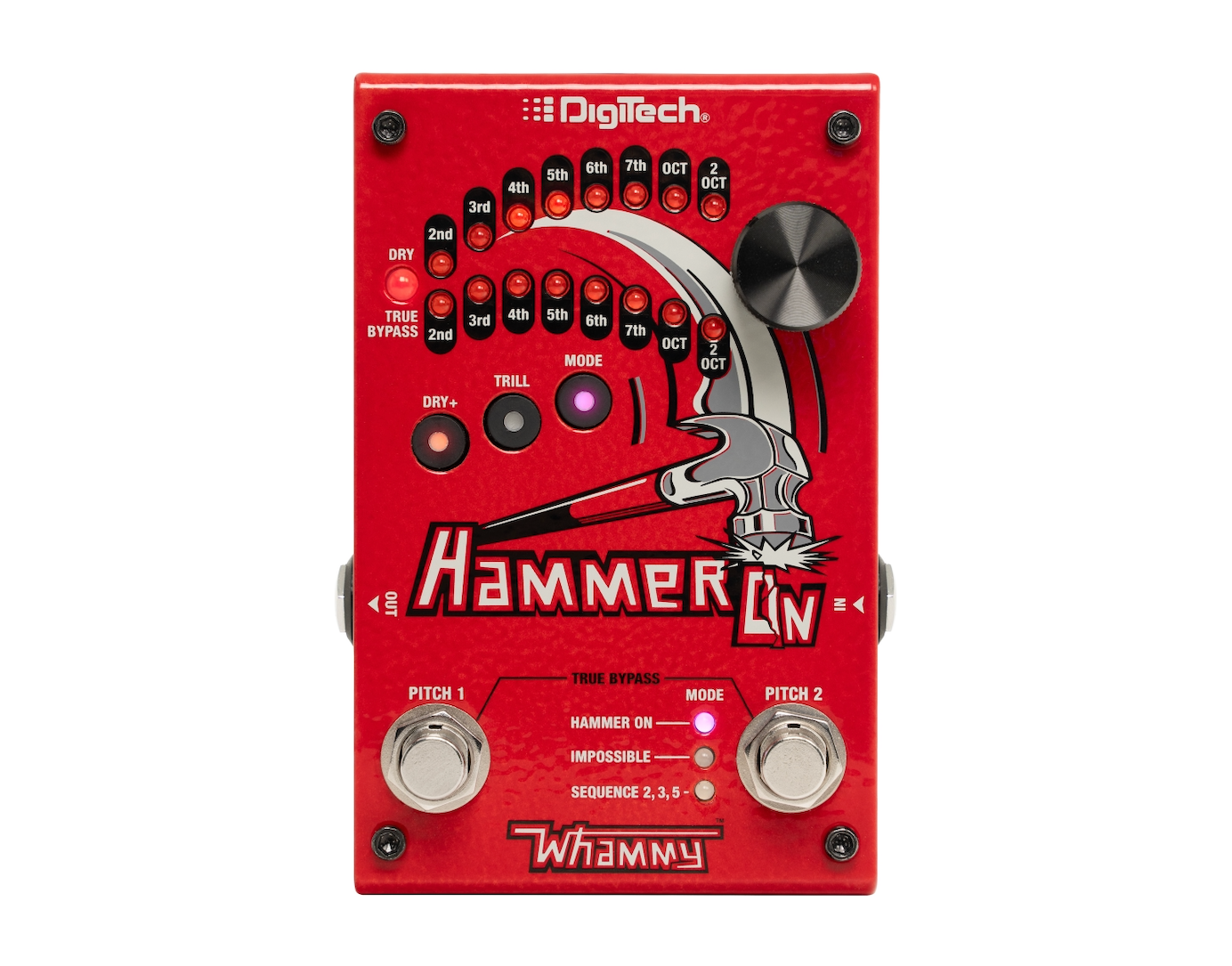
Digitech says its latest creation, the HammerOn pitch-shifting pedal, is “seven pedals in one.” That left me pondering what constitutes a “pedal” in this scheme. I think the more accurate and descriptive term may be “modes.” But those seven pitch-shifting modes deliver in really fun ways.
Operationally speaking, the HammerOn is fairly straightforward. When you step on either of the sturdy-feeling footswitches, whatever note(s) you play morph instantly to a different pitch of your choice. But this simple premise still makes the HammerOn a compelling addition to the Wham’ Fam’.
Mode Mentality
Hammer-on mode, which I essentially described above, is the most straightforward application of the pedal’s potential. But there is also an Impossible mode, which alternates between two different pitches, making once “impossible” fretboard maneuvers much more possible. Sequence mode strings together multiple pitch changes in different ways. And with any of these modes, you can add in your unaffected signal using the dry+ button or force the HammerOn to alternate pitches on its own with the trill button. According to the manual, these three modes, combined with the dry+ and trill buttons, account for the seven different “pedals” mashed together here.
“I even came up with a pretty strange-sounding chorus so odd that I giggled out loud.”
HammerOn’s modes, if not exactly independent pedals, are nevertheless capable of cool tricks. Certain pitch shift moves can work like a harmonizer, others like an alien 12-string emulator, and some like a capo that extends your guitar’s scale. In hammer-on mode, you hear plenty of the digital-icious glitchiness from the Whammy algorithm. You can also build sequences that evoke synthesizers, and it’s great, perverse fun to set the HammerOn to an odd interval like a flat 5th and smear otherwise pedestrian licks with a footswitch. I even came up with a pretty strange-sounding chorus so odd that I giggled out loud.
The HammerOn has plenty of practical uses, but its real magic lies in how it nudges you into unconventional musical territory, encouraging you to loosen your grip on habits and familiar fretboard patterns—much like the original Whammy. Ultimately, it’s a great tool for shaking creativity loose.
Ty Myers Rig Rundown
The TikTok star goes legit on his latest tour with some plum Strats, a Two-Rock, and a masterbuilt pedalboard.
When Ty Myers got injured a few years back and couldn’t play sports, he took to posting videos of himself on TikTok. Before long, his song “Tie That Binds” went viral on the platform, blasting him to overnight-star status. Now, with his debut album, The Select, under his belt, the 18-year-old is taking his songs on the road to packed-out rooms.
PG’s John Bohlinger linked with country’s newest wunderkind at the Egyptian Room in Indianapolis to see how he brings his old-time-meets-new-world country to life onstage.
Brought to you by D’Addario.
San Antonio Strat
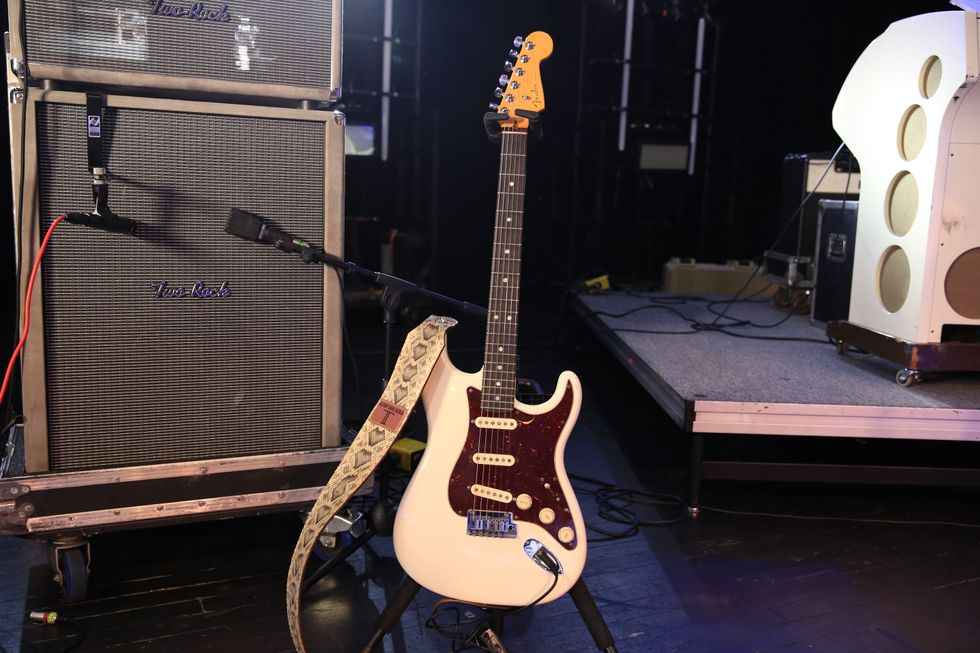
This Fender Stratocaster, the first nice guitar Myers bought himself, was purchased from a guy in a Home Depot parking lot in San Antonio, Texas. Myers swapped in Fender Custom Shop Fat ’50s pickups, and he strings it with Stringjoy .010s.
Eye-Catching Custom
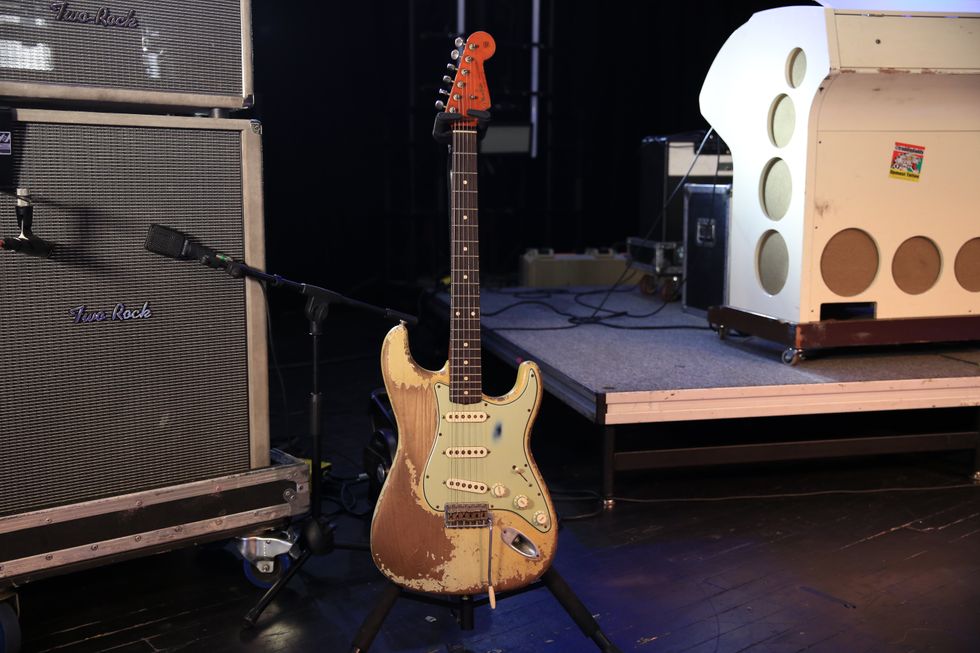
If Myers played slide, it’d be with this Custom Shop Master Built Strat, built by Dale Wilson. He went to Carter’s Vintage in Nashville with another instrument in mind, but this one caught his eye, and he had to have it. He kept the pickups it came with, and pretty soon he intends to have the action lowered.
Barry’s Bond
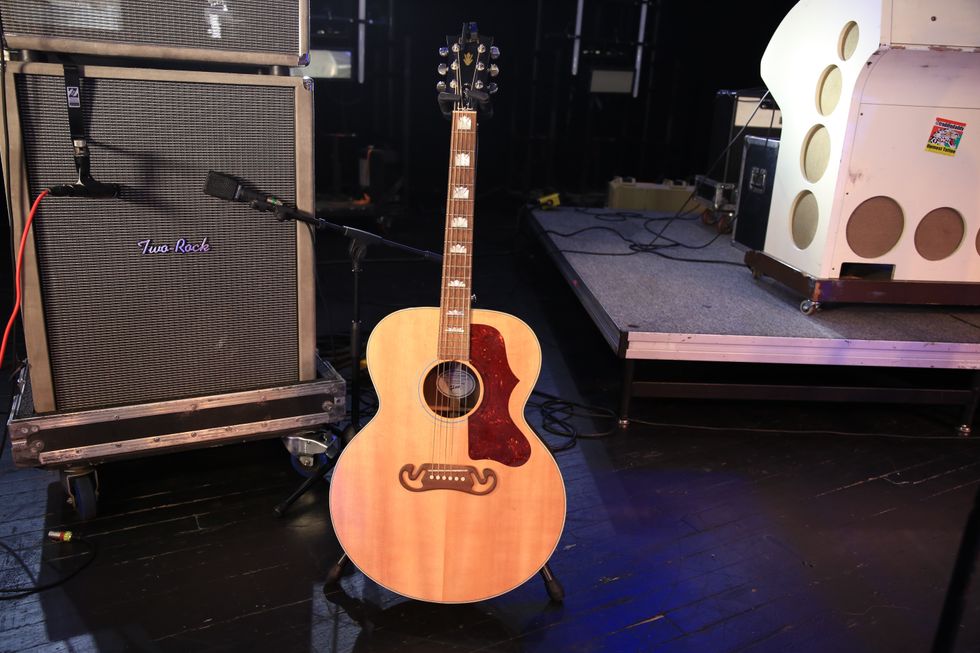
Myers got his first Gibson SJ-200 around the age of 10, and this one, a gift from label executive Barry Weiss, is his current go-to. It’s got an LR Baggs pickup system and goes direct to front-of-house.
Package Deal
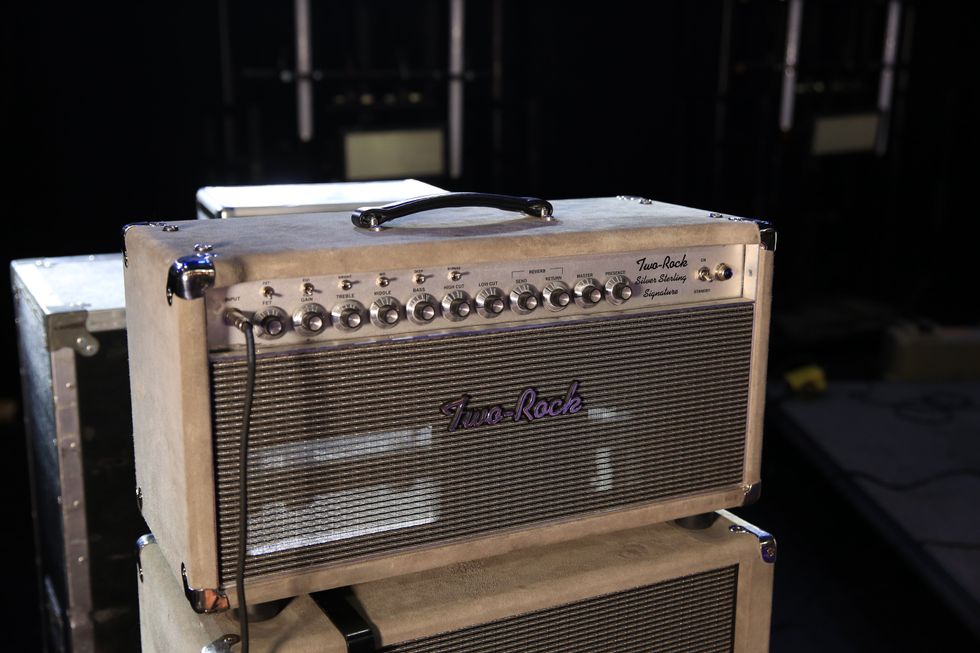
Myers’ biggest hero is John Mayer, so it tracks that he went after this Two-Rock Silver Sterling Signature. He saw this one at Carter the same day he bought his Custom Shop Strat, and didn’t even plug it in—he just bought it along with the Master Built.
Ty Myers’ Pedalboard
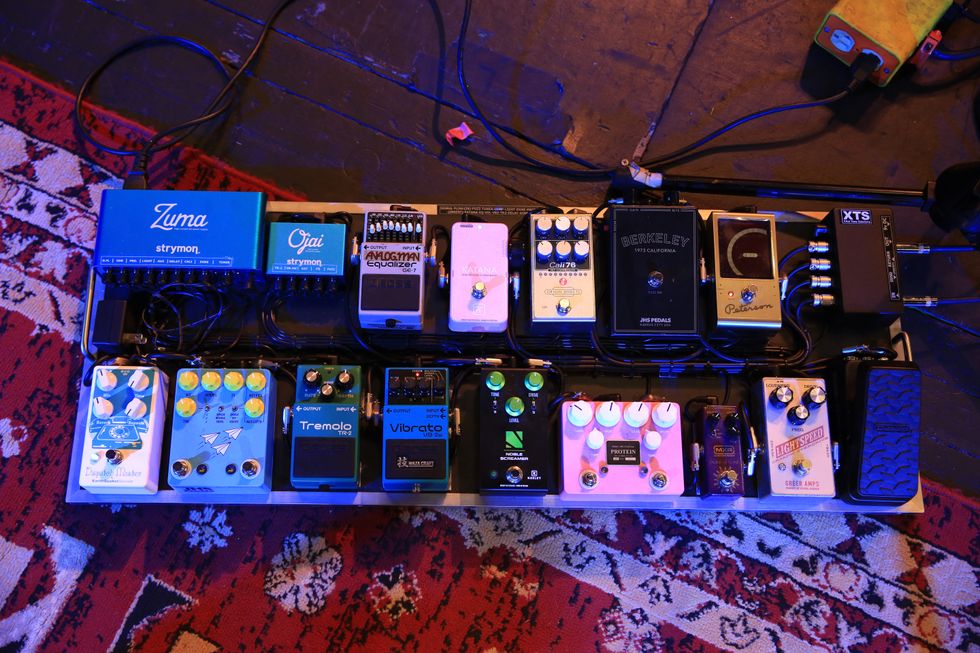
Myers’ stomp station was built by the pedal professors at XAct Tone Solutions in Nashville. After the Dunlop Volume (X) Mini and the Peterson StroboStomp LE, Myers’ signal hits an Origin Effects Cali76, JHS Pedals Berkeley, Keeley Katana, Analog Man/Boss GE-7, Greer Lightspeed, MXR Duke of Tone, Browne Amplification Protein, Keeley Noble Screamer, Boss VB-2w, Boss TR-2, JHS Flight Delay, and EarthQuaker Devices Dispatch Master. A Strymon Zuma and Strymon Ojai keep the lights on.

Fender Custom Shop Masterbuilt Stratocaster
EarthQuaker Devices Dispatch Master
Surfin’ Safari, Japan-Style: Meet the Intermark Cipher Surfer
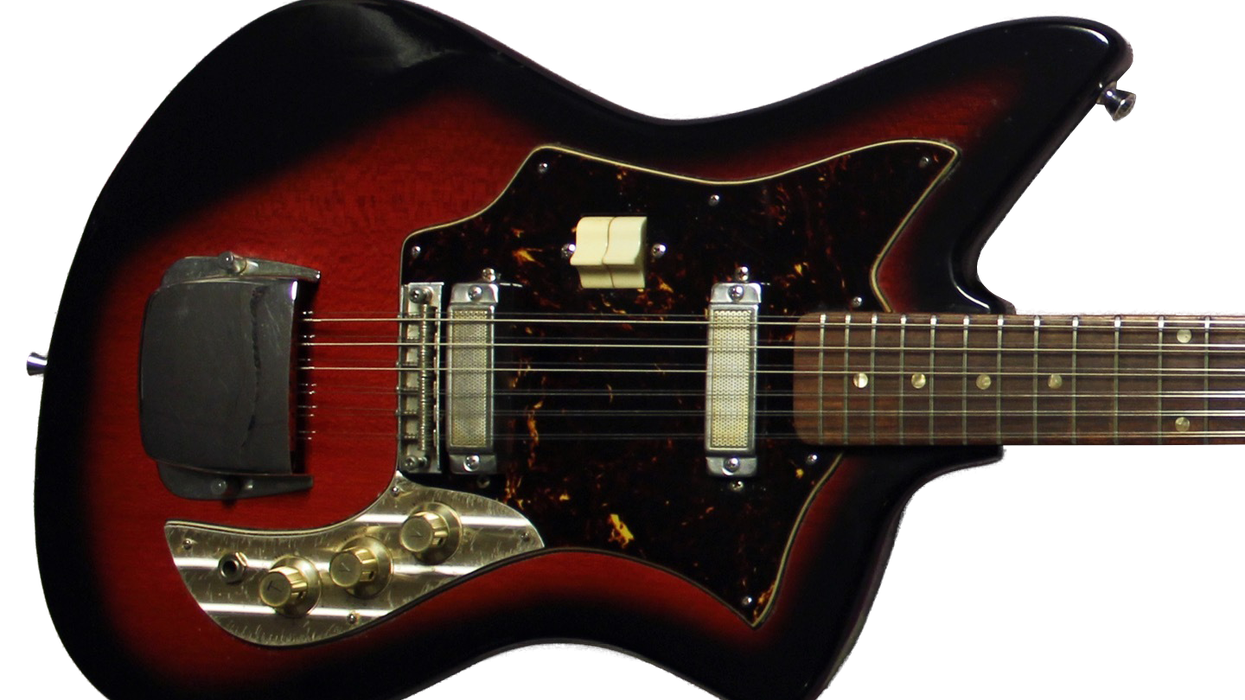
It’s about that time of the year when the family goes “down the shore,” as they say in my part of the world, for our annual vacation. We’ve been all up and down the East Coast shoreline, from Maine to South Carolina, but we usually settle in Delaware and all the quaint little escapes to be found.
Personally, I don’t really do much at the beach except meditate and people watch. Sometimes I don’t even bring a chair. Instead I just scoop out a “recliner” in the sand and ponder all sorts of musings. I’m fascinated by ocean living, and have wondered what it would be like to live at a house where you have to tie down your garbage cans so they don’t float away in a flood. At one point in our vacation we experienced a horrific thunderstorm and I had my son convinced that our car might float out into the ocean since we were right near the water. Good times!
So a few weeks ago, there I was on a Delaware beach thinking about life and how if I could choose to live anywhere or be anything, like a start-over, I think I would’ve enjoyed living along the shores of California and being a surfer. An idealized version, I suppose, but it seems cool in my mind. Of course I’d have to be 30 years younger, 50 pounds lighter, and operate with some semblance of balance, but hey, endless summers, baby!
In 1966 there was an awesome surfer documentary called The Endless Summer that chronicled a global search for the perfect wave. Director Bruce Brown’s film was filled with a cool soundtrack and the whole endeavor created a phenomenon of sorts which featured travel, music, culture, and a lifestyle that I just adore.
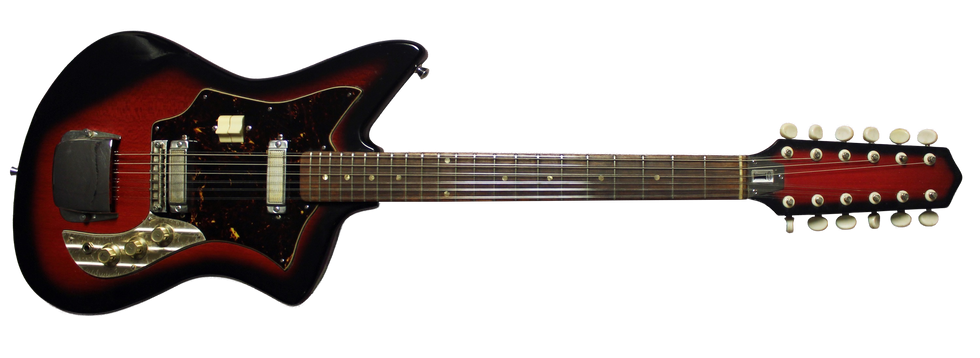
“Why would you associate a 12-string with surf music? The ’60s were different times.”
There were already plenty of surf bands at that time, such as the Ventures and Dick Dale, who embraced mostly instrumental music. That really appealed to fans around the world because the language barrier didn’t exist. And of course, there were a plethora of guitar ads that combined surfing with instruments. But sitting there in Delaware, I got to thinking about guitars that had “surf” in their name. There were newer models like the Charvel Surfcaster, but I was having a hard time coming up with vintage guitars. And then, just like a lightning strike during that coastal storm, it hit me … the Intermark Cipher Surfer from 1965!
For about two years, the Shinko Gakki Company in Japan produced electric guitars in the Tatsuno Lake region (which is a great spot to visit). Shinko guitars were mostly sold in Japan but most of the electrics sold in the States were imported by the Intermark Corporation in New York. Intermark imported all sorts of stuff from Japan and often the Cipher name was attached to products. Hence, the long-ish Intermark Cipher guitars. There were all sorts of configurations, such as basses and 12-strings along with a number of pickup configurations and, sometimes, super-cool colors such as yellow, green bursts, and wonderful glitter finishes. Now the rub here is this: They labeled the 12-string the Surfer. Why would you associate a 12-string with surf music? The ’60s were different times.
The Surfer did turn out to be an excellent guitar anyway, mainly because Shinko really tried to make solid instruments when it came to build quality, and especially the great-sounding pickups. Modeled after Italian EKO units, Shinko decided to make these pickups a little stronger with the 12-string. The body shape is reminiscent of a curling wave, I suppose, with its exaggerated offset points. But the first thing I noticed when playing the guitar was that the neck was really robust. On some 12-strings I often find my fingers cramped on the fretboard, but the Intermark Surfer had plenty of room because the fretboard was wide and the neck was deep. I never worried about this guitar going out of tune. Two volumes and one tone knob were paired with simple on/off switches for each pickup, and an overall fine bridge was enough to make the Byrds play surf music!
Can One Box Replace Your Whole PA?| Yorkville EXM Pro10
Yorkville EXM Pro10 Battery-powered 10-inch Portable PA Speaker
HighPerformance 10" Battery Powered PA
EXM Pro 10 Features:
- 10" woofer + tweeter, 134 dB max SPL
- 3-channel mixer w/ reverb, delay & compression
- Battery or AC powered (up to 12 hrs)
- Multiple EQ modes: Monitor, Live, Club
- Expandable w/ subs, stereo linking, external mixers
Marshall JVM, JCM800, JCM900, and DSL Pedal Reviews
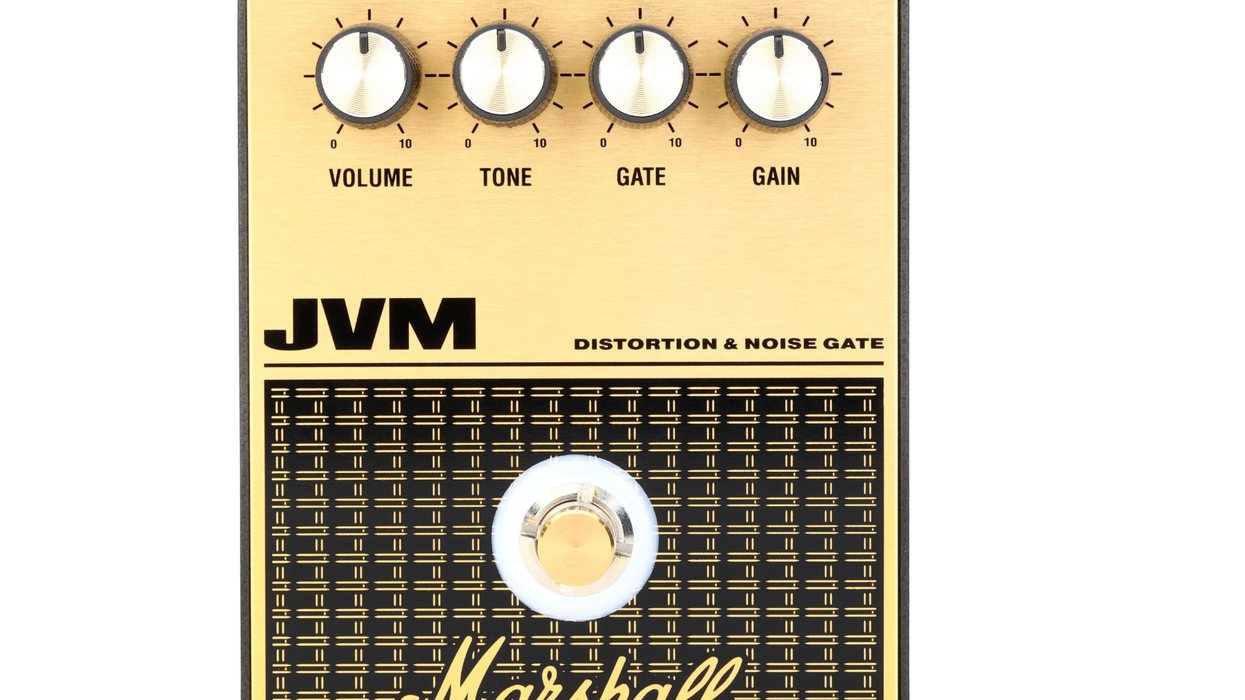
Marshall enters the amp-in-a-box ring with a series of true heavyweights that punch hard but can also dial back.
If you’d like to own a stable of classic Marshall heads but your budget won’t say “yes,” the legendary UK company may have a solution in the form of their recent line of amp-in-a-box overdrive pedals. They’ve put five of their greatest hits—the Super Lead (reviewed separately in our July issue), the JCM900, JCM800, the DSL, and the JVM—in 5" x 4" x 1 1/2" stomps, with a black-and-gold panel-and-grille-cloth motif. Sonically, they range from “nailed-it” to stunning. And at $159, all four total less than the tab for a 100-watt DSL head and just a bit more than the 20-watt version, to say nothing of the $2,899 it takes to grab a new JCM800. With this snarling, all-analog, true-bypass quintet, all you need is a solid pedal-platform amp and a humbucking or single-coil 6-string, and you’re in business.
Admittedly, my test amps were very solid: a Carr Vincent and the company’s Telstar. But I also have extensive experience with 800s and Super Leads, and I know a good time when I hear it. Whether spanking a PRS SE Silver Sky, a ’68 Les Paul Standard, a custom Zuzu with coil-splitting, or a been-through-Hell Tele with humbuckers, the results are gritty and sparkling, with rich midrange tones and plenty of articulate brightness in these pedals’ simple controls. And while these creations take a standard barrel-pin connector, they also run on 9-volt batteries, which makes them an easy drop-and-go asset for backline gigs.
JVM Distortion & Noise Gate
Generally, I’m a low-to-medium gain player…until I plug into a Marshall. At club and practice room volumes, I like to crank the gain all the way, use the master to set my level, and then adjust the tones with a prejudice toward floored mids, or close to that, and highs somewhere around 2 or 3 o’clock, depending on the amp and guitar combination. This modus operandi paid off immediately with the JVM. In fact, it was a rewarding strategy for each of these pedals.
What’s appealing to guitarists like Joe Satriani about JVM heads is their blend of controllability, touch response, grit, warm midrange, and singing sustain. The JVM has its grounding in the kind of classic Marshall tones initially made by the Super Lead, but with extra sizzle and snap via a lot of smooth, highly controllable, well-balanced gain.
Strapping in for a flight with all these pedals is the very definition of plug and play. The JVM has just four dials: volume, tone, gate, and gain. The gate is perfectly effective. If you’re cranking the gain, just dial up the gate until the hiss disappears. And unlike many gates, it leaves your core tone shining. The tone control has range enough that the amp’s 3-band EQ is not missed (at least by me). And while the pedal can get very loud, rolling back the gain to noon-ish and peeling off the gate creates nice low-gain-amp tones not typically associated with JVM heads. That makes this pedal a joy to play and, whether you’re a high-gain or low-gain partisan, gives it the potential to lead you to tonal places outside your usual wheelhouse.
Ratings
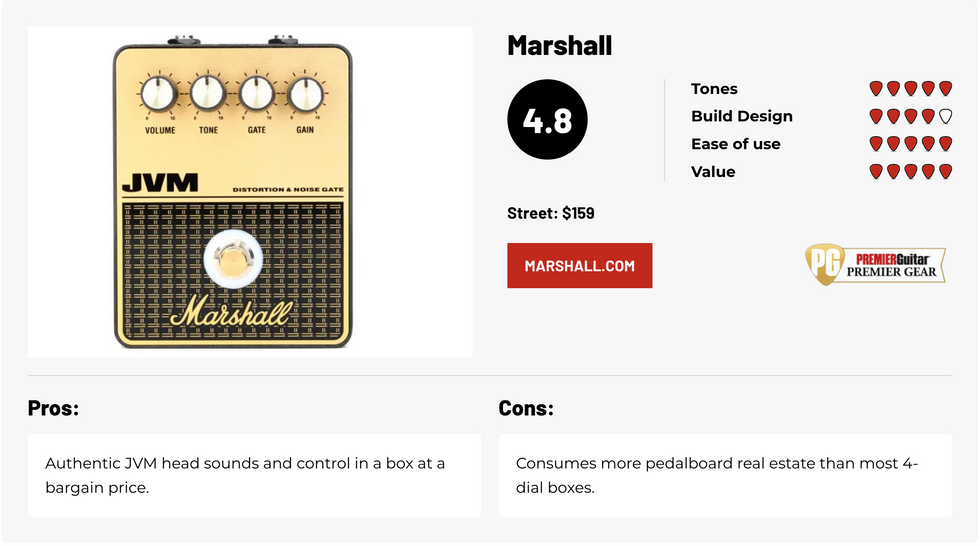
JCM800 Lead Series
This is a pedal version of Marshall’s flagship ’80s head that helped produce many of that decade’s defining guitar voices—most notably, perhaps, Slash’s. Like the other boxes in Marshall’s new silicon-based overdrive stomp series, it rekindles those voices admirably. Its overall sound is a little looser than the JVM pedal, with a somewhat darker character, which might make it an appealing Marshall gateway for players who typically go low-gain but yearn for a taste of the wild side.
The JCM800 has plenty of controllability and volume in its 4-dial setup. Here, the knobs are gain, volume, and tone, naturally, with the addition of sensitivity. Sensitivity isn’t the same as presence, which boosts upper-midrange and treble frequencies. Instead, the sensitivity dial controls the amount of signal that goes into the preamp stage of an amp. The higher it’s turned, the more tube saturation and gain. (In older Marshalls, this aspect of tone coloration was often accessed by jumping the high and low inputs of amps like the Super Lead with a short cable.)
Keep both this dial, which emulates that process, and the gain low, and the JCM800 pedal takes a softer route, with less growl and a looser response to your fingertips and picking. Turn it up and the sound becomes nasty and more harmonically rich and reactive. In my opinion (and I toured with a JCM800 for years), these amps and this pedal have a buzzing quality in their sonic character until the gain is pushed to 2 or 3 o’clock, the tone past noon, and, in the pedal’s case, the sensitivity moves to about 2 o’clock. At these settings, the volume needs to rise to about 10 o’clock or better for the tone to open up, and that’s really pushing it in smaller rooms. But there are some great voices in the blend, and setting sensitivity to 10 o’clock, cranking the gain all the way, moving the tone to 1 or 2 o’clock, and the volume to 3 or so delivers lovely hard-rock crunch. Of course, that’s all subjective and influenced by what amp you’re pushing these pedals through, so the best test, as always, is firing one up for yourself.
Ratings
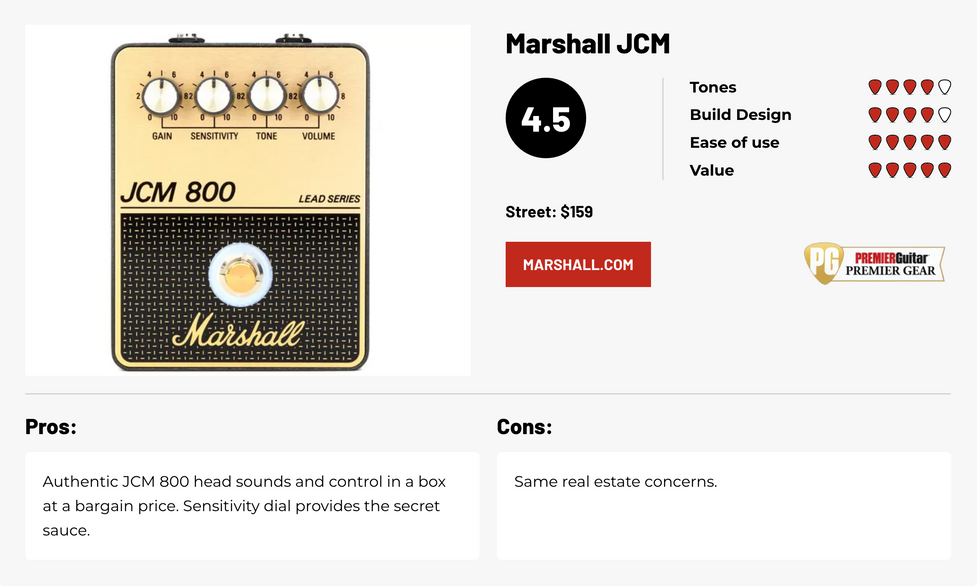
JCM900 Hi Gain Distortion
To my ears (and fingers), JCM900 heads have a tighter sound and are more responsive to your hands than 800s. I got the same impression playing this pedal too, which makes the JCM900 more genre-flexible, in my book. The secret sauce in this stompbox is administered via the contour control, which joins the gain, tone, and volume dials. Turn it down and the mids become scooped; turn it up and they are pushed to the fore.
This box is capable of tight ’80s and ’90s rhythm sounds, with the gain at 3, contour at 6, tone straight up, and the volume wherever makes you happy. Overall the tones are sparkling and snappy. Push the contour higher and mid-heavy lead sounds soar out, especially with the tone past 2 or 6 o’clock. This territory is blues-rock paradise. But my favorite setting was with the gain full-on (of course), the contour and tone around 1 o’clock, and the volume at 11 o’clock, crafting a blend of tough, biting, and sweet. I didn’t find the JCM 900 as versatile as the JVM or DSL pedals, but it’s nonetheless a charmer and, depending on your palate, may be perfect for your tastes.
Ratings
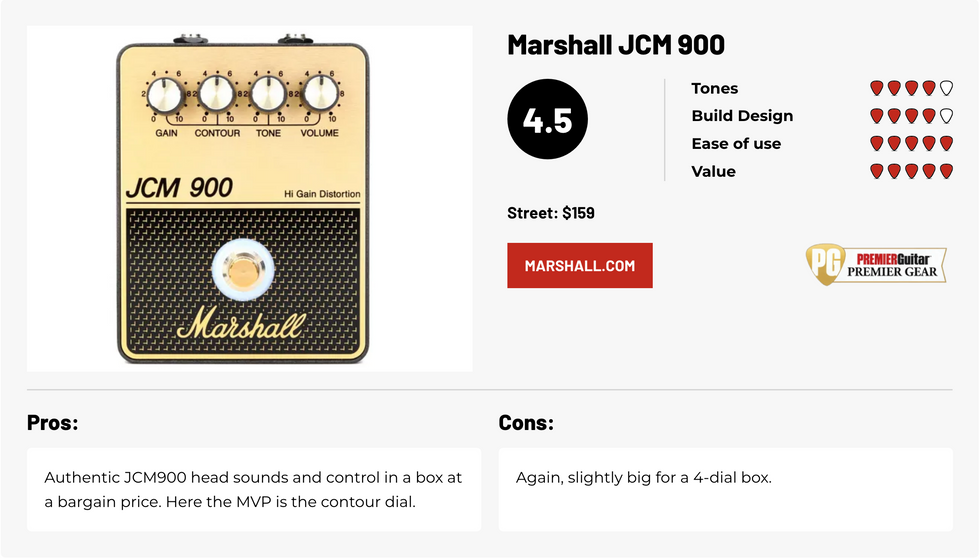
DSL Dual Super Lead Distortion
Introduced in 1997, the Marshall DSL, or Dual Super Lead, was designed to be a 2-channel Clydesdale. It’s the amp that embraces the widest spread of classic Marshall tones. Its vocabulary nods to all its heavyweight predecessors, and it’s capable of sounds that are clean and ringing as well as gnarly distortion. That versatility makes it a good partner for just about any style except folk music, unless you like your folk with a lotta attitude. (On the jazz side, Sonny Sharrock, who was a JCM800 player, would have dug this amp, too.)
This pedal is patterned on the amp’s second channel, which gleefully leans into higher gain and distortion levels. Setting the dials—gain, deep, tone, and volume—at 11, 10, noon, and 3 o’clock respectively delivered the sort of scalding, dirty rhythm sounds I associate with Pearl Jam. But turning the volume back a bit, I was reminded of a Fender Bassman with an overdrive pedal in front. In fact, on all these pedals, volume and gain are satisfyingly interactive, just like the amps that serve as their foundation.
For the DSL stompbox, the deep dial also plays an important role in this sort of mimicry. It is a low-end boost, which is especially valuable at quieter volumes, adding, well, depth, as advertised. Between the depth and tone control, the pedal offers a wide range of sonic character. And, of course, with the gain floored, it burns.
Playing through Marshal’s JVM, JCM800, JCM900, and DSL Pedals was an absolute delight, like having a fleet of toothy, world-class amps at my disposal. And they come at a bargain price. I recommend treating yourself to your own test flight as soon as possible.Ratings
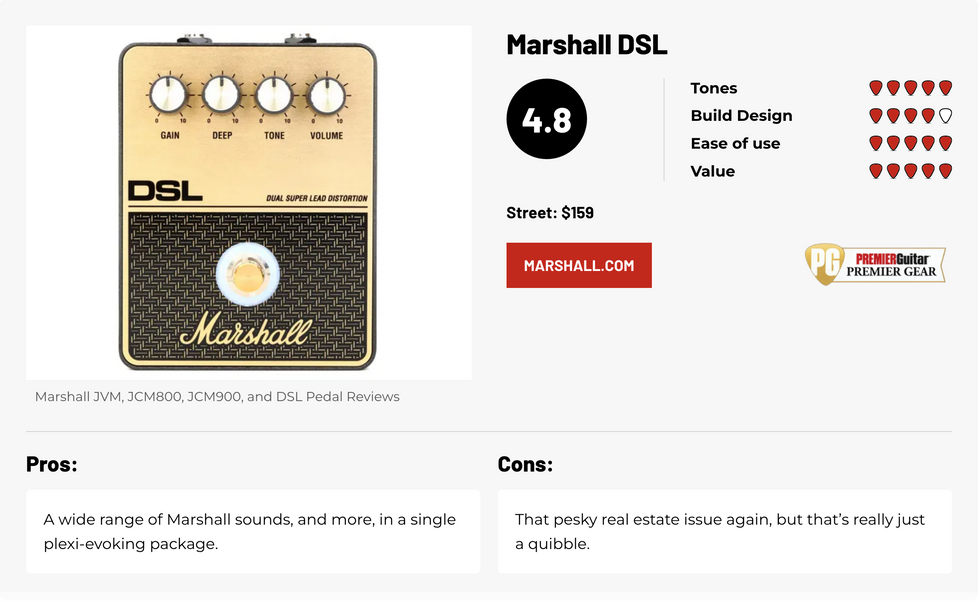
Marshall JVM, JCM800, JCM900, and DSL Pedal Reviews

Marshall enters the amp-in-a-box ring with a series of true heavyweights that punch hard but can also dial back.
If you’d like to own a stable of classic Marshall heads but your budget won’t say “yes,” the legendary UK company may have a solution in the form of their recent line of amp-in-a-box overdrive pedals. They’ve put five of their greatest hits—the Super Lead (reviewed separately in our July issue), the JCM900, JCM800, the DSL, and the JVM—in 5" x 4" x 1 1/2" stomps, with a black-and-gold panel-and-grille-cloth motif. Sonically, they range from “nailed-it” to stunning. And at $159, all four total less than the tab for a 100-watt DSL head and just a bit more than the 20-watt version, to say nothing of the $2,899 it takes to grab a new JCM800. With this snarling, all-analog, true-bypass quintet, all you need is a solid pedal-platform amp and a humbucking or single-coil 6-string, and you’re in business.
Admittedly, my test amps were very solid: a Carr Vincent and the company’s Telstar. But I also have extensive experience with 800s and Super Leads, and I know a good time when I hear it. Whether spanking a PRS SE Silver Sky, a ’68 Les Paul Standard, a custom Zuzu with coil-splitting, or a been-through-Hell Tele with humbuckers, the results are gritty and sparkling, with rich midrange tones and plenty of articulate brightness in these pedals’ simple controls. And while these creations take a standard barrel-pin connector, they also run on 9-volt batteries, which makes them an easy drop-and-go asset for backline gigs.
JVM Distortion & Noise Gate
Generally, I’m a low-to-medium gain player…until I plug into a Marshall. At club and practice room volumes, I like to crank the gain all the way, use the master to set my level, and then adjust the tones with a prejudice toward floored mids, or close to that, and highs somewhere around 2 or 3 o’clock, depending on the amp and guitar combination. This modus operandi paid off immediately with the JVM. In fact, it was a rewarding strategy for each of these pedals.
What’s appealing to guitarists like Joe Satriani about JVM heads is their blend of controllability, touch response, grit, warm midrange, and singing sustain. The JVM has its grounding in the kind of classic Marshall tones initially made by the Super Lead, but with extra sizzle and snap via a lot of smooth, highly controllable, well-balanced gain.
Strapping in for a flight with all these pedals is the very definition of plug and play. The JVM has just four dials: volume, tone, gate, and gain. The gate is perfectly effective. If you’re cranking the gain, just dial up the gate until the hiss disappears. And unlike many gates, it leaves your core tone shining. The tone control has range enough that the amp’s 3-band EQ is not missed (at least by me). And while the pedal can get very loud, rolling back the gain to noon-ish and peeling off the gate creates nice low-gain-amp tones not typically associated with JVM heads. That makes this pedal a joy to play and, whether you’re a high-gain or low-gain partisan, gives it the potential to lead you to tonal places outside your usual wheelhouse.
Ratings

JCM800 Lead Series
This is a pedal version of Marshall’s flagship ’80s head that helped produce many of that decade’s defining guitar voices—most notably, perhaps, Slash’s. Like the other boxes in Marshall’s new silicon-based overdrive stomp series, it rekindles those voices admirably. Its overall sound is a little looser than the JVM pedal, with a somewhat darker character, which might make it an appealing Marshall gateway for players who typically go low-gain but yearn for a taste of the wild side.
The JCM800 has plenty of controllability and volume in its 4-dial setup. Here, the knobs are gain, volume, and tone, naturally, with the addition of sensitivity. Sensitivity isn’t the same as presence, which boosts upper-midrange and treble frequencies. Instead, the sensitivity dial controls the amount of signal that goes into the preamp stage of an amp. The higher it’s turned, the more tube saturation and gain. (In older Marshalls, this aspect of tone coloration was often accessed by jumping the high and low inputs of amps like the Super Lead with a short cable.)
Keep both this dial, which emulates that process, and the gain low, and the JCM800 pedal takes a softer route, with less growl and a looser response to your fingertips and picking. Turn it up and the sound becomes nasty and more harmonically rich and reactive. In my opinion (and I toured with a JCM800 for years), these amps and this pedal have a buzzing quality in their sonic character until the gain is pushed to 2 or 3 o’clock, the tone past noon, and, in the pedal’s case, the sensitivity moves to about 2 o’clock. At these settings, the volume needs to rise to about 10 o’clock or better for the tone to open up, and that’s really pushing it in smaller rooms. But there are some great voices in the blend, and setting sensitivity to 10 o’clock, cranking the gain all the way, moving the tone to 1 or 2 o’clock, and the volume to 3 or so delivers lovely hard-rock crunch. Of course, that’s all subjective and influenced by what amp you’re pushing these pedals through, so the best test, as always, is firing one up for yourself.
Ratings

JCM900 Hi Gain Distortion
To my ears (and fingers), JCM900 heads have a tighter sound and are more responsive to your hands than 800s. I got the same impression playing this pedal too, which makes the JCM900 more genre-flexible, in my book. The secret sauce in this stompbox is administered via the contour control, which joins the gain, tone, and volume dials. Turn it down and the mids become scooped; turn it up and they are pushed to the fore.
This box is capable of tight ’80s and ’90s rhythm sounds, with the gain at 3, contour at 6, tone straight up, and the volume wherever makes you happy. Overall the tones are sparkling and snappy. Push the contour higher and mid-heavy lead sounds soar out, especially with the tone past 2 or 6 o’clock. This territory is blues-rock paradise. But my favorite setting was with the gain full-on (of course), the contour and tone around 1 o’clock, and the volume at 11 o’clock, crafting a blend of tough, biting, and sweet. I didn’t find the JCM 900 as versatile as the JVM or DSL pedals, but it’s nonetheless a charmer and, depending on your palate, may be perfect for your tastes.
Ratings

DSL Dual Super Lead Distortion
Introduced in 1997, the Marshall DSL, or Dual Super Lead, was designed to be a 2-channel Clydesdale. It’s the amp that embraces the widest spread of classic Marshall tones. Its vocabulary nods to all its heavyweight predecessors, and it’s capable of sounds that are clean and ringing as well as gnarly distortion. That versatility makes it a good partner for just about any style except folk music, unless you like your folk with a lotta attitude. (On the jazz side, Sonny Sharrock, who was a JCM800 player, would have dug this amp, too.)
This pedal is patterned on the amp’s second channel, which gleefully leans into higher gain and distortion levels. Setting the dials—gain, deep, tone, and volume—at 11, 10, noon, and 3 o’clock respectively delivered the sort of scalding, dirty rhythm sounds I associate with Pearl Jam. But turning the volume back a bit, I was reminded of a Fender Bassman with an overdrive pedal in front. In fact, on all these pedals, volume and gain are satisfyingly interactive, just like the amps that serve as their foundation.
For the DSL stompbox, the deep dial also plays an important role in this sort of mimicry. It is a low-end boost, which is especially valuable at quieter volumes, adding, well, depth, as advertised. Between the depth and tone control, the pedal offers a wide range of sonic character. And, of course, with the gain floored, it burns.
Playing through Marshal’s JVM, JCM800, JCM900, and DSL Pedals was an absolute delight, like having a fleet of toothy, world-class amps at my disposal. And they come at a bargain price. I recommend treating yourself to your own test flight as soon as possible.Ratings

Gibson Tones, Epiphone Price: The 1960 Les Paul Special Double Cut Demo
Raw, rowdy, rugged, and won’t break the bank—a no-frills double cutaway delivers on its decades-old streamlined design promise with USA-made P-90s.
The Gibson Les Paul Special was first introduced as a single cutaway model in 1955, and with the exception of the sunburst Standards that were produced from 1958-1960, it was the last of the original50s-era Les Paul model variants to be introduced. An enhanced version of the Les Paul Junior with increased sonic flexibility, it featured two P-90 pickups instead of the single P-90 found on the Junior and also added a bit of extra bling in the form of a bound fretboard and a mother-of-pearl headstock logo. In 1958, the body shape was revised from a single cutaway to a double cutaway, which delivered improved fretboard access, and the Special hit its stride in 1960 when a thinner SlimTaper neck profile and a lower neck pickup placement made it more robust and easier to play than ever.
Now, Epiphone, in partnership with Gibson Custom, is proud to introduce the 1960 Les Paul Special Double Cut Reissue, an Inspired by Gibson Custom recreation of the sought-after 1960 Les Paul Special Double Cut. Like the originals, it features a slab mahogany body with double cutaways that provide excellent access to the entire length of the fretboard. The one-piece mahogany neck has a fast-playing 60s SlimTaper profile and is capped with a rosewood fretboard with 22 medium jumbo frets and mother-of-pearl dot position marker inlays. The fretboard has a 12” radius that makes playing first-position chords and solos with string bends further up the neck equally effortless. The Gibson “open book” style headstock is equipped with Epiphone Deluxe three-on-a-plate tuners with white buttons and a GraphTech nut to help keep the tuning nice and stable, while a historic style Wraparound bridge with intonation screws solidly anchors the strings at the other end and contributes to the excellent sustain that the Les Paul Special is famous for. A pair of USA-made P-90 Soap bar pickups from Gibson Custom that can go from sweet and clean to outright nasty and dirty-sounding are hand-wired to individual volume and tone controls with high-quality CTS potentiometers and Bumblebee paper-in-oil capacitors for authentic vintage tones that are sure to please even the most tone-conscious players.
The 1960 Les Paul Special Double Cut Reissue comes packaged in a vintage-style case with a brown exterior and pink plush interior that features Inspired by Gibson Custom graphics on the exterior. It all comes together to deliver a vintage playing and ownership experience at an accessible price that is special in every way.
Deep Divin’ on the Allmans with Alan Paul | 100 Guitarists Podcast
As a longtime music journalist and author of the Allman Brothers books One Way Out: The Inside History of the Allman Brothers Band and Brothers and Sisters: The Allman Brothers Band and the Inside Story of the Album That Defined the ’70s—both New York Times bestsellers—Alan Paul is foremost authority on the Allmans who was never in the band.
He’s also a guitar player who leads the band Friends of the Brothers and is deeply attuned to the nuances of each of the many Allman Brothers guitarists.
On this episode, we’re covering the whole history of the band’s guitar chairs, from Duane Allman and Dickey Betts to Derek Trucks and Warren Haynes and the many others who’ve stepped in to he spotlight with their 6-string.
Thanks to our Sponsor Rock Mountain Slides
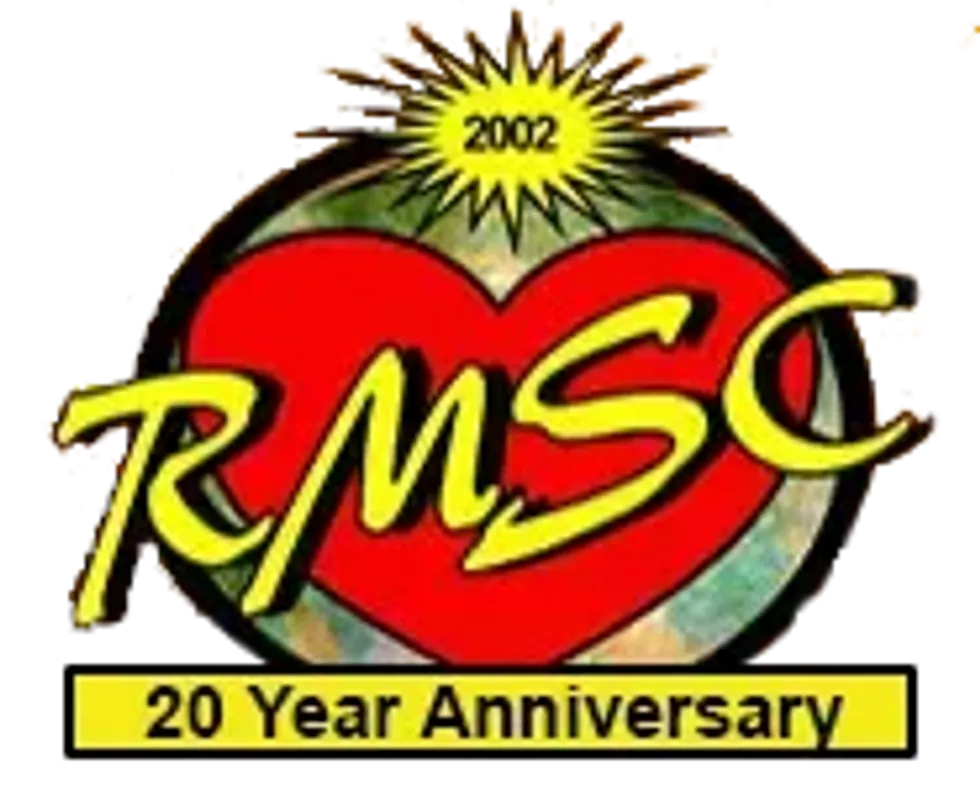 Learn More at rockymountainslides.com
Learn More at rockymountainslides.com
DR Introduces Black Dragon Multi-Scale Bass Strings
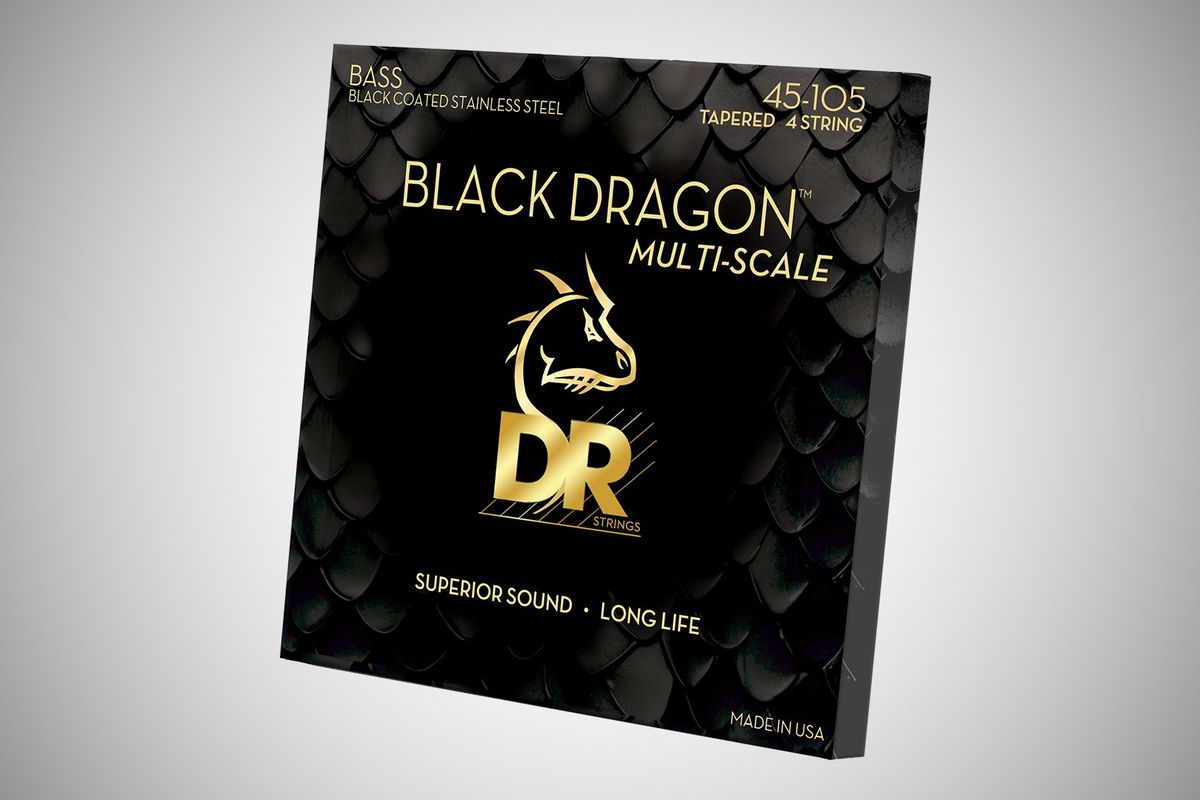
DR Handmade Strings has introduced their highly engineered new Black Dragon Multi-Scale Bass strings. Combining the sound, feel and extra-long life of Dragon Skin+ with an exciting black finish, these new strings will bring out the best tone (and look!) of any multi-scale bass, including those with up to 37” B strings.
The new Black Dragons are available in 4-string, 5-string and 6-string sets and feature DR’s patented Accurate Core Technology (ACT). ACT upgrades the architecture of the strings, allowing them to vibrate to their full potential and deliver full tone and clarity for even the lowest notes of your bass. The stainless steel strings feature DR’s Black K3 coating that protects the strings, without choking off the sound, and gives the strings a distinctive black appearance to compliment any instrument. The net result? A great-looking string that delivers enhanced tone, effortless playability and extra-long life.
Black Dragons carry street prices of $39.99 (4-string set), $49.99 (5-string set) and $52.99 (6-string set). They will be available starting August 17th in honor of DR Strings founder Mark Dronge’s 87th birthday. For more information visit drstrings.com.
Holy Grail 'Bursts: BEST OF Rig Rundown
The likes of Joe Bonamassa, Jason Isbell, and Richie Faulkner walk us through a carousel of vintage Gibson Standards
Trace the journeys of some of the world’s rarest guitars including cherry sunbursts pulled from pawnshops, a scorching ’59 that simply refused to be left behind, and more. Along the way these legends debunk hand-winding myths, detail meticulous restorations, and share the emotional pull of instruments that have crossed continents and shaped Rock and Roll.
Mile End Effects Pique Review
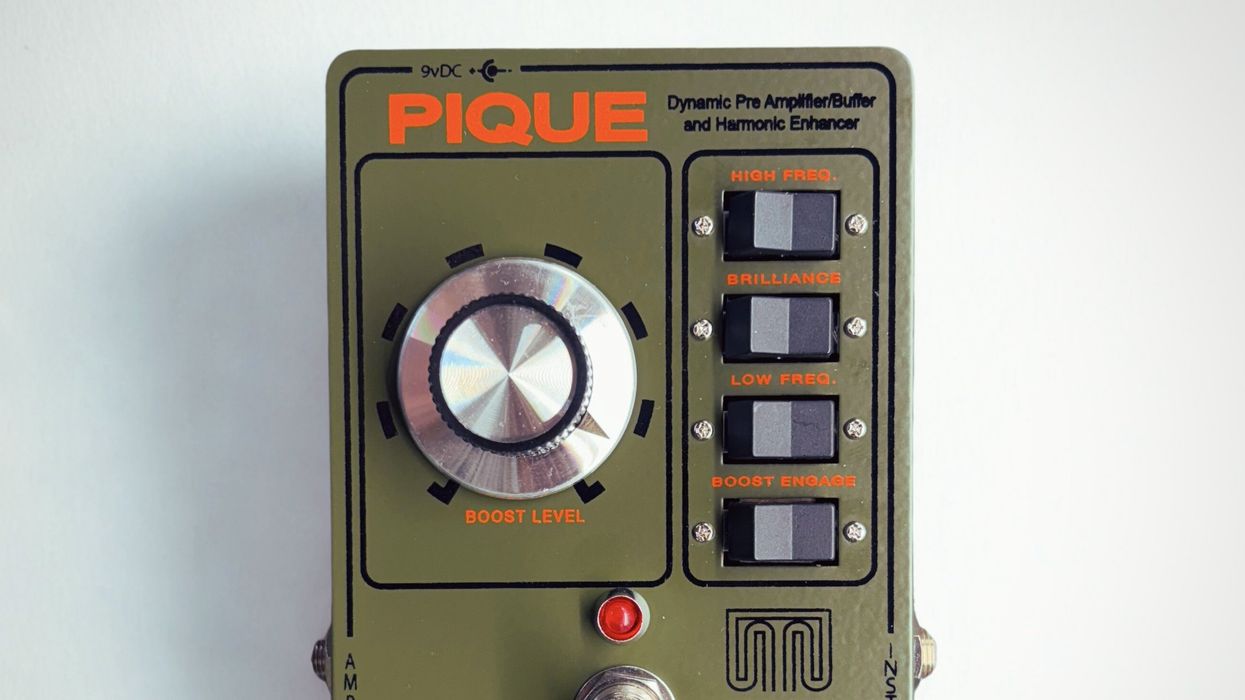
A handsome 3-in-1 boost, EQ, and filtering stomp offers unique tonalities.
Mile End Pique Demo Vid
Mile End Effects’ Justin Cober, who runs the one-man operation out of his Montreal basement, advertises the Pique as a “dynamic preamplifier, buffer, and harmonic enhancer.” That’s a mouthful for what looks like a fairly simple stomp with single knob and four rocker switches, but the Pique lives up to the billing. It’s one of the more creatively stimulating and inspiring boost/EQ/buffer combos I’ve encountered.
Pique Behind the Curtain
The Pique’s design is rooted in the company’s Preamp 150, which is an homage to the preamp in the Roland RE-150 Space Echo. But the Pique has a much wider range of capabilities. Rather than just boosting one frequency or another, the Pique creates, as Cober puts it, “higher-order harmonics by implementing filtering, very slight phase shifts, and musically related harmonics to the audio signal.” Each of the three EQ-related switches functions a little differently.
The brilliance switch employs a capacitor to filter low-end frequencies and emphasize midrange. The “high freq” control runs upper frequencies through an op-amp circuit that generates distortion and extra harmonic content, while lower frequencies remain unaffected. “Low freq,” on the other hand, uses a phase-shifted low-pass filter to achieve similarly targeted saturation and compression on the opposite end of the EQ spectrum.
The boost switch activates the Preamp 150 section, and the unit’s prominent knob controls the effect’s level. This all makes the Pique a cinch and a pleasure to use: four switches, one knob, less overthinking, more playing. Keep in mind that the pedal requires 250 mA to operate—a much higher draw than most boost or EQ pedals. It’s more than the draw from most simple boost or EQ pedals.
Pique Performance
The Pique’s buffer can be activated alone by turning all the rocker switches off and turning the pedal on. It gives a just-noticeable lift to a dry signal, especially in the airy high frequencies that drip away over a lengthy signal chain. Switching on the Preamp 150 boost circuit takes that lift further, lending presence, chime, and breadth to whatever you feed it. It’s a great always-on effect, but the extra clarity and sparkly high end make it a great lead boost if you kick up the level.
The harmonic excitement aspect of the pedal, though, is where the Pique opens up new avenues. Cober’s design considerably thickens selected frequencies, which feels like the sonic equivalent of turning a fine-tip pen into a broad, inky marker. And rather than simply a surgical, colorless EQ bump, the Pique’s frequency boosts often feel like distinct, specialized effects that blend overdrive, clean boost, and EQ. They accentuate certain elements of your guitar’s signal, for sure, but they also stretch them with subtle harmonics and sometimes delicate, almost imperceptible distortion.
These functions are especially rewarding when the Pique is applied after your dirt pedals, where it excites and texturizes certain elements of other pedal tone profiles. If you’re missing bottom-end heft, flip on low freq, and instead of a blunt bass boost, you’ll perceive a more powerful and immediate low-end character. Add in brilliance and your mid frequencies will experience a similar metamorphosis, yielding much grittier prominence. High freq can yield the same pleasing effect, though some players will want to be careful about how it highlights rogue high frequencies from gain devices in front of the Pique.
The Pique isn’t your average boost or EQ pedal. It’s full of unique sounds that are clearly a product of inventive circuit-tinkering, but also hits the mark for many basic EQ, buffer, and boost functions. To top it off, Cober’s circuit design is matched by his aesthetic eye. Pique is definitely one of the best-looking stompboxes on the market.
PRS Guitars Releases New Rules of Tone Video Series
PRS Guitars today released the first episode of a new video series on the PRS “Rules of Tone.” The Rules of Tone is a document written by Paul Reed Smith back in 2006, in which he documented 21 “rules” that he and the guitar makers at PRS follow in order to ensure instruments of the highest quality.
“It was meant to be a guide so that I/we always build the best instruments we can possibly make. There are 21 rules – each one the culmination of decades of experience in guitar-making, design, and repair work. While no set of rules can guarantee a perfect instrument, a guitar should improve with each instance of a rule followed – in the end becoming greater than the sum of its parts,” said Paul Reed Smith.
The video series will be published as six episodes in total. Episode 1 focuses on woods and is available now at this link. Remaining topics include: necks, pickups, finish, hardware, and setup. In each video, Paul Reed Smith is joined by a member of the PRS Guitars manufacturing team to talk about how the guitar-making philosophies are applied in practice on the manufacturing floor. To see each episode as soon as it is released, subscribe to the PRS Guitars YouTube channel and click the bell for notifications.
“Since 2006, I have spent a lot of time teaching these guitar-making principles to the teams here. The teams have, in turn, become stewards of the rules to every person who makes guitars for PRS. Please enjoy these videos. It is my hope that they give you an idea of the amount of care and constant improvement we dedicate ourselves to, so that you receive our best,” said Paul Reed Smith.
PRS Guitars continues its schedule of launching new products each month in 2025. Stay tuned to see new gear and 40th Anniversary limited-edition guitars throughout the year. For all of the latest news, click www.prsguitars.com/40 and follow @prsguitars on Instagram, Tik Tok, Facebook, X, and YouTube.
The Glen Campbell Effect

Glen Campbell’s sound is inspiring on many levels—in addition to his distinctive voice, his nuanced and virtuosic guitar playing allowed him to interpret some of the most iconic songs of his era. Among them, the songs of Jimmy Webb stand out immediately. Classic pieces such as “By the Time I Get to Phoenix” and “Wichita Lineman” are instantly recognizable for their vivid storytelling and unforgettable melodies. It’s interesting to note that Webb composed on piano, utilizing the instrument’s vast harmonic capabilities to craft structures less conventional than the typical radio single.
In the hands of Campbell, his guitar playing truly shines as much in his comping as in his famous soloing during live performances. I composed my piece, “Jed’s Theme,” based on a character in a novel written by my sister, Christina Rauh Fishburne, with Webb and Campbell’s influence very much at the center. It can be heard on my album with Cameron Mizell, Local Folklore (Destiny Records).
Note: I play this piece with hybrid picking (pick/middle/ring), but it can also be played fingerstyle if that’s more comfortable.
Ex. 1 (Measures 1–8)
The beginning of the tune establishes a simple melody line over a harmonic bed that utilizes inversions and substitutions for color. An element of Campbell’s accompaniment style that I love is his ability to sculpt emotion to support the melody. In an instrumental context like this, using a Gm as a passing thought in measure 2 is a way to emote harmonically while only briefly straying from the key of D major. The decision to use F# in the bass of the tonic D chord also provides a chromatic line as we move through D/F#, Gsus4, Gm, D/F#, and G6. These nuanced voicing movements help to create an atmosphere for the melody beyond the typical options. The rocking back and forth of the bass notes also provides a momentum to move up to the V–IIIm–IV cadence that ends with a first position line over Gmaj. Adding such lines in an instrumental tune can be a fun way to insert “guitar” back into the melody. By this I mean that until then, think of the melody as a voice. The melody sings its entrance and comes to a pause, leaving space for the guitar to respond before moving on.
Ex. 2 (Measures 9–16)
Here, we find ourselves back in the “voice” melody but now E/G# is introduced as a harmonic shift to bring light into the melodic narrative before closing out the phrase by resolving to a Dmaj walk up. At the start of the song, the melody hangs on the G6 chord before extending tension over the V and IIIm chords and settling on the IV chord before beginning its next statement. This time, we bring the melody to a secondary dominant with the V of V (E/G#) before finally resolving to the I chord. This is a mechanism often found in the Webb/Campbell songs that allows a melody to remain consistent while simultaneously offering emotional development.
Ex. 3 (Measures 17–23)
We begin here with a higher melodic line voiced over the V chord before descending out of the key briefly to Fmaj7–Fmaj9–Cadd9. Following this, another “guitar” line enters to lead us back into D major by closing out the phrase on A7, further utilizing harmonic movements under the melody to introduce new emotive colors and support the melody.
Ex. 4 (Measures 9–13, coda ending)
To bring the song to an end, we take the D.S. al Coda and introduce a final harmonic shift with the G/Ab beginning the coda and ending on the unresolved Gm. These choices are both ways in which a song can be brought to a closing that feels open-ended, which is different than incomplete. Rooted in the key of D major, the song remains mostly grounded in the tonality with various harmonic divergences to accent the melody. By ending the song on the Gm, or the IVm, we may insinuate that a story is still being told after the song is finished. This is a mechanism often used to accentuate unresolved tension in vocalized lyrics and can have the same effect with instrumental music when thoughtfully placed.
Ex. 5
For Ex. 5, we’ll play the complete piece, keeping in mind that it’s important to hear the melody lyrically, and the harmony as emotional color in support of it.
Shure Nexadyne Mics on Tour with Deep Sea Diver
PG's Chris Kies catches up with Jessica after filming DSD's latest Rig Rundown to get her first impressions of the Nexadyne lineup.
Deep Sea Diver's Jessica Dobson is a longtime fan of Shure mics on stage and in the studio. So, when Shure outfitted their latest tour with the new Nexadyne series mics, the band was excited to put them through their paces to see how they stack up against legends like the sm57 and sm58 for reliability and tone.
Shure Nexadyne 5 Guitar Amp Microphone
Nexadyne 5 Amp Mic, Blk
The Nexadyne™ 5 Dynamic Guitar Amp Microphone is a supercardioid dynamic microphone for professional live performance, featuring patented Shure Revonic™ dual-engine transducer technology.
Shure Nexadyne 8/S Dynamic Vocal Microphone
Nexadyne 8/S Supercard Vocal Mic, Blk
Dynamic Vocal Microphone with Cardioid Pickup Pattern, Dual-engine Design, Revonic Transducer Technology, Dent-resistant Grille, Mic Clip Stand Adapter, and Zipper Case
Shure GLXD16+ Digital Wireless Guitar Pedal System
GLXD16+ Wls Gtr Pedal Sys
Verso Sine Review
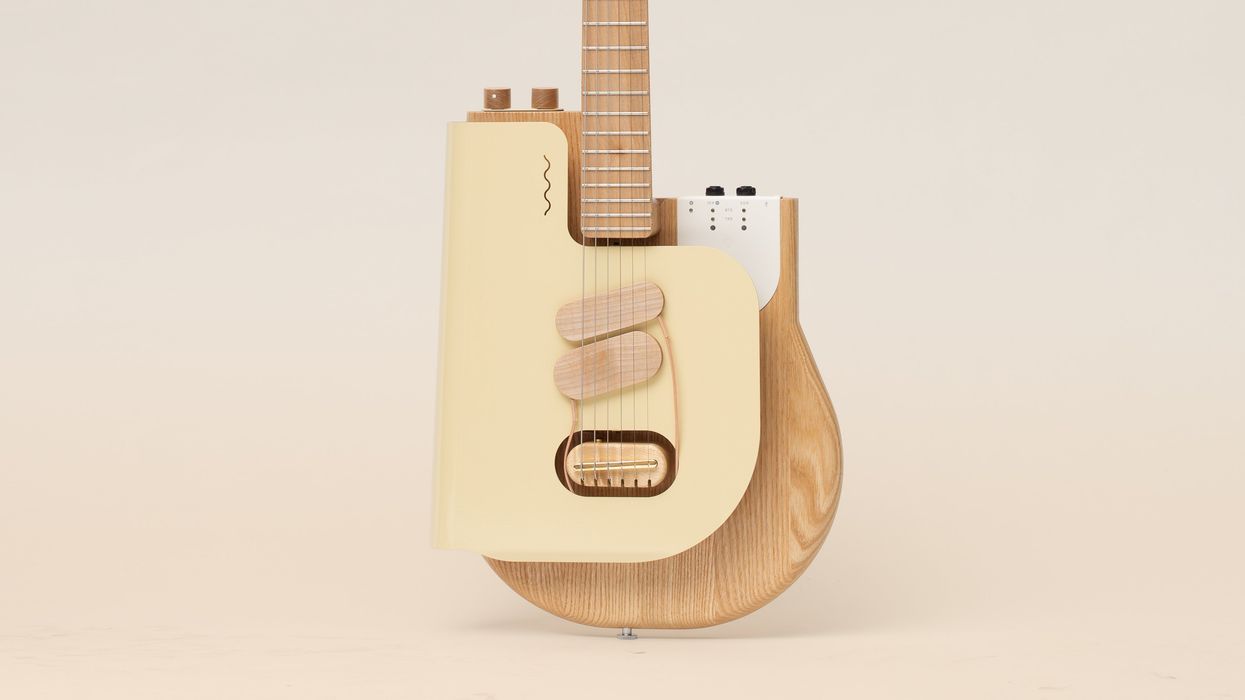
Verso demo
Over the course of electric guitar history, there have been many experimental builds. Some have been successful and changed the path of guitar design, while others have come and gone, surfing the seas of change. The Verso Sine, though, lives in a third, less common category—an artistic realm populated by names like Wandre and Manzer, where visionary builders rule the roost.
Since launching Verso a handful of years ago, Germany-based builder Robin Stummvoll has caught the attention of intrepid design fans with his minimal, sheet-metal-bodied Cosmo guitar, Orbit baritone, and Gravis bass. His distinctive style is based on future-leaning aesthetics that also draw on the early history of electric guitar design—specifically Rickenbacker’s sheet-metal lap steels—as well as mid-century furniture and architecture.
With the Sine, Verso pushes further ahead. Aesthetically, this model would sit nicely in the design wing of a modern art museum, maybe across the hall from an Eero Saarinen exhibit. That alone is cause for excitement. But the Sine, described by Stummvoll as an “expressive guitar,” offers a playing experience unlike any other guitar I’ve laid my hands on. And that is the real experiment at the heart of this fantastic instrument.
Rethinking Guitar Design
Unlike its metallic siblings, the Sine is actually made of a solid ash body with a set neck—available as ash, maple, cherry, oak, or walnut—with the option of a 16" or compound 9 1/2"–16" radius. The Sine Pad, a 1 mm-thick piece of bent sheet metal that’s affixed to its body, serves as the guitar’s top and home to the pickups.
The Sine Pad opens up a world of possibilities that are game-changing, highly innovative, and practical. First, there’s the pickups. Since the Sine Pad is powder-coated steel, the magnetic pickups cling to the top without needing to be permanently affixed, so they can be moved in any direction. That means they can be shifted in relation to the strings to shift the tone. But thanks to stereo-output options (which are configured on the back of the guitar, where the guitar’s input jack is located, and where the pickups plug in via mini audio jacks), both of the Sine’s single-coil pickups can be moved so one pickup captures only the top strings and the other captures just the bottom. The resulting stereo imaging effects can be pretty wild.
Because the Sine Pad is a floating, spring-loaded piece of sheet metal and the brass bridge is independently situated on the body, you can also create volume-swell effects by pressing on the top without changing pitch. I found that a different kind of musical intuition comes into play when working with the Sine Pad. The control it offers is more nuanced and directly tied to my picking hand technique than what I would achieve with a volume pedal or knob. It’s a great tool for quick, expressive swells.
Volume isn’t the only control the Sine Pad has to offer. An onboard LEHLE EXPRESSION module is connected to the Sine Pad, with two expression outs (it’s also compatible with CV and USB MIDI) that I used to control pedals with expression options. Plugged into my Red Panda Tensor or Moog Minifooger MF Delay, I experienced a sense of effect control like never before. I tapped into delay times both subtle and extreme with the same intuitive gestures that controlled my chord and note attack. It’s something I haven’t been able to emulate without the Sine—a unique feeling almost like playing with a whammy bar for the first time.
The Essential Guitar-ness of the Sine
The Sine’s wild innovations wouldn’t mean much if it weren’t an excellent guitar. Sure, it looks completely unlike anything else. But holding the Sine in my lap, closing my eyes, and putting fingers to frets and strings, it’s a comfortable, playable instrument. It’s a little body-heavy, and the lack of curvature on the lap side means it can drift if you don’t sit with it centered. But those issues aside, the drawbacks are few.
The fretboard feels great, and there’s plenty of access to each of the Sine’s 22 nicely rounded Jescar frets. Acoustically, it’s loud and resonant, with warm but metallic overtones similar to my Jazzmaster with an aluminum pickguard, or a fuller, bigger guitar version of my sheet-metal Rickenbacker NS lap steel. The pickups certainly play a role in balancing the metallic overtones, and their wooden housing even gives a little extra sense of warmth, at least visually. Yet as fun as it is to lean in and dose the Sine with enough effects to match its futuristic tendencies, this well-rounded sonic foundation demanded I spend just as much time using its clean tone to play complex voicings across the neck.
The Verdict
The Sine is essentially an experimental instrument for daring players looking for something different. It absolutely succeeds, however, not only by offering a range of expression unlike any other guitar, but by doing so in a way that is simple and practical—a combination that defined the greatest mid-century guitar-design icons. I’ll share one warning for those who experiment with this guitar, though: Since parting with the Sine, I’ve missed the sense of expression it put at my fingertips, and there’s only one way to experience that feeling again.





